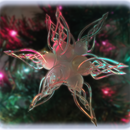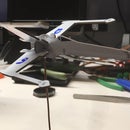Introduction: Frame Mount (2020/1515) Universial Spool Holder
For those who just want assembly instructions please go to step 2
About 6 months ago I started designing a 3d printer. I know, I Know, ... not another rep-rap printer.
I really want to have a printer that I made and designed. I might design something new in the process or I might not. I'm have a good time, so what the heck...
One of the things I needed was a spool holder. I thought it would be the easiest part of the printer to make. So, I tackled it first.
One of the biggest things I have learned is you never design anything in just a few iterations. For this spool holder I have made 3 different basic desiges and had many many revisions of each until I got one I was happy with. I must have about 200 interations before I got what you have now. Not to mention all the printing filament I used. (about 3 lbs)
This seems like such a simple thing, why 200 interations. Well, in few words - tolerance stack up. The metal parts have quit bit of deviation, 3d printers also have quit a bit of deviation, especially the home built rep-rap type. (of which mine is). Most of there metal parts need to be a press fit. I had one person on Thingiverse say everything was loose. Another said they could not get anything to fit. Same files, different parts and printers.
If you have problems during construction drop me a line and I will do my best to help you.
--------------------------------------------------------------------
All the files for this design are located on Thingiverse. http://www.thingiverse.com/thing:1040823
Step 1: The Design
This is a list of my design criteria before starting on the spool holder.
Criteria:
- Attaches to the printer - My delta printer uses 2020 aluminum extrusions, 1515 are also very common. The mount will be designed for those in mind.
- Spool rotates freely. - The use of some sort of bering would be good. I have tried using a small stick attached to the side of my printer. It worked, for the most part, but during certain situations it staved the printer for fillament. Prints where not consistent. Smooth easy movement is needed to print well.
- No Adjustment needed for different spool sizes - The holders that sit on your desk and use berings on the edges of the spool need to be adjusted for different widths of spools. I just want to put the spool in and start printing. No messing around.
- Easy Spool installation / removal - Some sort of clamping set up would wok well for different widths.
Now that I have a design concept its time to get some details worked out.
Richard Horne's blog (link here) out lines many of the problems with multiple spool types in his blog.
It's a good read for a 3d printer geek. It was a GREAT help to me.
Richards blog details the sizes of many spool types. That data was used to design this holder.
To start my design I tally the inner hole side of all the spools.
The hole size wher from 19mm - 74mm. This would dictate a clamping taper design. (Many spool holders do this, this is not a new idea)
After several different attempts I came up with the basic design. After that it was a matter of fine tuning the print volume and tolerance stack up.
As you see from the picture the design will (if sized properly) meet many of the criteria.
--------------------------------------------------------------------
All the files for this design are located on Thingiverse. http://www.thingiverse.com/thing:1040823
Step 2: The Parts You Will Need and Need to Print
This is a parts lis for the holder.
- Set of the 3d printed parts.
- One of the 2 bases. (1515 or the 2020)
- One frame side holder
- One frame side holder center
- One of the two out side holders. (Nut trap or the threded)
- Bearing 16mm x 5mm x 5mm Sealed (AKA 625ZZ) - Quantity 2
- M5 Drop in Tee-Nut for 20x20 al extrusion - Quantity 2
- M5 Nut (McMaster Carr No 90592A012) - Quantity 1
- M5 x 35mm Socket Cap Screw (McMaster Carr No 91239A238) - Quantity 1
- M8 x 24mm Hex Coupling Nut (McMaster Carr No 90009A222) - Quantity 1
- M5 x 8mm Socket Cap Screw (McMaster Carr No 91239A222) - Quantity 2
- M3 x 8mm Socket Cap Screw (McMaster Carr No 91239A113) - Quantity 3
- M8 x 80mm Hex Head Screw(McMaster Carr No 91280A576) - Quantity 1
In the pictures; all the 3d printed parts are present. There are 2 different out side clamping parts (threded type and Nut trap type) and 2 different base parts (20mm width and 15mm width for different aluminum extrustions ).
All screws are fully threaded. That means from the head to the tip the threds have been cut.
A note about print settings:
These files should be printed with a .2mm layer high (or better) and a 40% infill (or better). Base 1515.stl, Base 2020.stl, Frame Side Holder Center.stl, Frame Side Holder.stl, and Outside Side Holder.stl.
The Outside_Side_Holder_Threaded.stl file should be printed at a layer hight of .15mm (or better) with an infill of 40% (or better).
Files for the build have NOT been attached to this instructable.
Basically for 3 reasons.
- The original design is there; I only want to maintain files on one place.
- The 3d printer designs are licensed under the "Creative Commons - Attribution - Non-Commercial license". Having files all over the place may put that in jeopardy. Not sure, but thats what I am doing.
- Gregory Nutt (Thingiverse - timeshell) made the the threaded version of the outside holder. He did not want to make a Thingiverse variant of my parts so he sent me the file. But it is still HIS work. At this time he has only consented to have it on Thingivers.
--------------------------------------------------------------------
All the files for this design are located on Thingiverse. http://www.thingiverse.com/thing:1040823
Step 3: Work From the Out Side to the Frame Side
Now take the 8mm x 24mm Hex Coupling Nut and insert in the back of the "Outside_Holder" part. (Picture 1) The nut trap on that part is tapered. So, the nut should slide in easily. See picture 2.
To fully seating the nut will hold it in place. It will take some bit of force. To do this, insert the 8mm Hex screw in the back of the part. Screwing it 90% of the way into the M8 25mm nut. Now place the assembly in a clamp; as shown in picture 3.
I put the clamp in a vice to make this process easy.
Slowly turn the handle of the clamp until the nut reaches the stop in the top of the cone. Be carful. If it looks like you are damaging the plastic part, stop. The nut does not need to be all the way to the front to do its job.
Once that is done you can remove the 8mm hex bolt. (the one in the picture 3 is 160mm, it's 2x the one you will have)
Picture 4 is what it looks like when the Coupling Nut is fully seated.
--------------------------------------------------------------------
All the files for this design are located on Thingiverse. http://www.thingiverse.com/thing:1040823
Step 4: Install Berings
Now we are going to install the bearings. These need to be pressed into the holder that was 3d printed with the file "Frame_Side_Holder.stl". This press fit is very important. If the bearings are loose in there cups the entire holder will be very wobbly.
You will need the M5 screw and nut. Pass the M5 screw though one of the bearings. Then place the bering and screw inside the Holder. Now place the second bearing on the other side of the holder. Then screw on the M5 nut. (see picture 1)
Using a het key wrench and a pair of pliers tighten the nut down on the bearings. Eventually the bearings will seat in the holes provided. Then remove the M5 screw and nut. (see picture 2)
--------------------------------------------------------------------
All the files for this design are located on Thingiverse. http://www.thingiverse.com/thing:1040823
Step 5: Inserting the Nut in the Base
There is a nut trap in bottom of the base. It is very tight. Again, it is on purpose. Place the Base in a vice as shown in picture 1.
Take the M5 x 35mm screw and run it through the hole. Then pun the nut on the back side of the screw.
Take a par of pliers and align the nut with the nut trap. Using an allen wrench start tightening the screw. The nut will be pulled into the nut trap. Once the nut has started its way into the trap the pliers are no longer needed.
Use the M5 screw to fully seat the nut in the nut trap. Then remove the screw.
--------------------------------------------------------------------
All the files for this design are located on Thingiverse. http://www.thingiverse.com/thing:1040823
Step 6: Screw on the Base
Now we will add the base.
Take the M5 x 35mm screw and pass it through the frame side holder. Now add the base to the other side of the holder. Using a hex wrench tighten the base on the holder. Tighten the screw just enough to keep the base from wobbling. Don't tighten it so much that the bearings have problems moving.
When you are done. Hold the base and flick the holder with your finger. The holder should spin for a good bit. If not; it's to tight.
--------------------------------------------------------------------
All the files for this design are located on Thingiverse. http://www.thingiverse.com/thing:1040823
Step 7: Add the 8mm Screw to the Center
Now the shaft of the spool holder.
The M8 screw need to be inserted into the frame side center piece. See picture 1. The nut trap of the center pice is tapered. Inserting it for the first few mm is easy. (see picture 2).
To get the M8 screw to fully seat in the nut trap us the outside holder part to pull it in. (see picture 3) The screw head is fully seated when the screw head is past the holes on the sides of the part. (see picture 4).
The last bit is very important. When this part is screwed in place; the side screws go right behind the M8 screw head. This not only will hold the center in place but also keep the M8 screw from backing out.
--------------------------------------------------------------------
All the files for this design are located on Thingiverse. http://www.thingiverse.com/thing:1040823
Step 8: Install the Frame Side Holder Center
Now insert the center pice into the frame side holder. It should go right in. If you are having problems look for blobs or miss prints on the parts. Remove them.
Ailing the hols on the outside of the part with the ones on the inside. Again, If this does not happen you may need to clean up the part.
Take 3 m3 screw and insert them into the holes on the side of the part. They are very hard to screw in. The score is basically taping the plastic. DO NOT USE A DRILL \ SCREW GUN TO PUT THESE IN. They will strip out. Then your starting over.
--------------------------------------------------------------------
All the files for this design are located on Thingiverse. http://www.thingiverse.com/thing:1040823
Step 9: Install It on the Printer
Install the M5 x 8mm screws in the base and add the T-nuts. Put the entire assembly on the printer and Letter RIP! :)
--------------------------------------------------------------------
All the files for this design are located on Thingiverse. http://www.thingiverse.com/thing:1040823
Step 10: DONE!
Just some pictures of the holder doing it's job Holding. :)
I hope you liked this Instructable. If please click the vote button. :)

Participated in the
3D Printing Contest 2016













